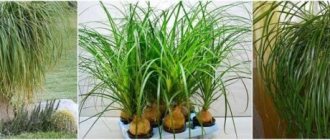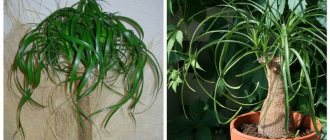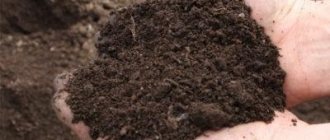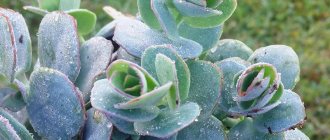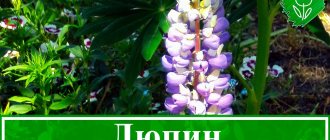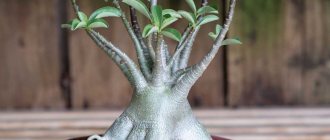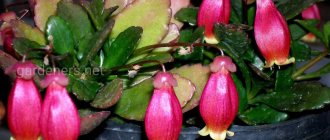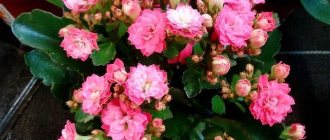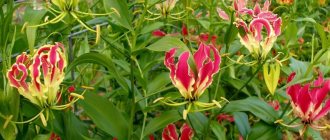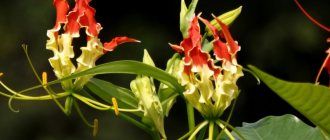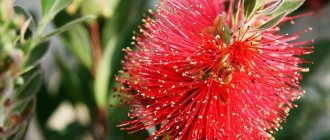Author: Elena N. https://floristics.info/ru/index.php?option=com_contact&view=contact&id=19 Category: Houseplants Published: December 12, 2013Last edits: January 11, 2021
- Nolina longifolia / Nolina longifolia
Botanical description
Nolina (lat. Nolina) belongs to the Asparagus family of plants, mainly growing in natural conditions in the southern United States and Mexico. Another botanical name for the plant is Bocarnea, and it is popularly called “Horse Tail” because of the shape and arrangement of the leaves, or “Elephant Foot” because of the shape of the trunk. Indoor nolina is usually a low plant. This is a bottle plant - the nolina trunk expands at the base. This extension serves as a water reservoir that helps the plant survive long dry periods, and the thin leaves allow moisture to evaporate slowly, making the plant resistant to moisture stress. Growing the plant is quite simple. The pot needs to be shallow, since the root system does not go deep - in nature, nolina grows on rocky soils. The plant is grown as an ornamental deciduous plant, since it is almost impossible to achieve flowering indoors. Looks good as a single plant.
Light
These plants will grow slowly and although will do well in a slightly shaded location, they need bright light to thrive. If you provide some sun, within a few weeks you will see the plant turn this into lush new leaves, meaning more light means more growth.
Nolina plants grown in the shade should not be suddenly moved and thrown into a very sunny location. Move the plant to this new location for a few hours a day and then back again. Do this for a week to get used to the change in light intensity. This will prevent the leaves from becoming disfigured.
Briefly about cultivation
- Flowering: grown as an ornamental foliage plant and does not bloom indoors.
- Lighting: bright diffused light throughout the year.
- Temperature: in spring and summer - normal for residential premises; in winter, the plant should be kept at 10-12 ºC, but the temperature should be lowered gradually.
- Watering: using the bottom watering method: in spring and summer - abundantly, after the earthen lump in the pot has completely dried, in winter watering is scanty.
- Humidity: normal.
- Fertilizing: nolina does not need fertilizer, but if necessary, add a solution of mineral fertilizer, the concentration of which is four times weaker than suggested in the instructions.
- Dormant period: from November to March.
- Transplantation: after a dormant period: up to 3-4 years - annually, for older nolins - once every 2-3 years.
- Substrate: 2 parts sand and one part each of peat and leaf soil.
- Reproduction: seeds and shoots.
- Pests: mealybugs, scale insects and spider mites.
- Diseases: trunk rot.
Read more about growing nolina below.
Transfer
If it grows well, it can be replanted once a year. If conditions are not so good or you want to limit the size of the plant, only replant every 2 or 3 years.
As long as you feed them about once a month, these houseplants still do well in small pots, and although most of them are above the surface, the roots can be quite compact, as seen in Nolina's photo.
When it's time to replant, there are no special soil or tips to follow. Standard everyday soil will do, just make sure it's fresh and not old or used. In terms of appearance and cosmetics, you can try using a tall container to keep the long leaves from dragging on the ground.
Caring for nolina at home
Lighting
Lighting throughout the year should be bright but diffuse. Exposure to direct sunlight is harmful for nolina at home, so the plant is grown on eastern and western windows, and on southern windows they are placed at a distance. In winter, during the dormant period, nolina needs bright light, so additional artificial lighting may be required.
Temperature
In summer and spring during the growing season, room temperature is suitable; no special conditions need to be created. If in winter it is possible to keep indoor nolina at a temperature of about 10-12 °C, by September the temperature is gradually reduced, preparing the plant for the dormant period. If in winter the plant grows at temperatures above 18 °C, then there will be no dormant period, and the nolina flower will continue to grow all year round. In summer, the plant can be taken outside, covering it from precipitation and wind. A draft can destroy the plant.
Watering Nolina
In spring and summer, water abundantly, but rarely. How this is done: a pot of nolina is lowered into a container of water and taken out when the soil is completely wet, after which the excess water is allowed to drain for half an hour. Next time you will need to water only after the entire earthen ball has completely dried out. Overmoistening of the soil is detrimental to the plant. The houseplant nolina should be watered in the same way if it overwinters at high temperatures. If in winter the temperature drops below 15 °C, then water less often and more carefully, and if wintering takes place at 10 °C and below (dormant period), then nolina is not watered. If you pour nolina indoors in winter (at low temperatures), this will most likely lead to the death of the plant.
- Phalaenopsis: how to water, fertilize and replant
Spraying
Spraying is not at all necessary when growing indoors, since spraying is more conducive to wetting the soil - in nature, the leaves of the nolina plant collect dew, which flows to the center of the rosette and along the trunk to the soil. You can sometimes spray the plant and wipe the nolina leaves with a damp cloth. You need to take soft, settled water, or better yet, boiled water.
Top dressing
Homemade nolina grows beautifully and quite quickly even without fertilizing if you care for it properly. You can also feed, but only in half the concentration and only during the growing season (spring and summer). Complex mineral fertilizers are suitable for feeding and are applied no more than once every 20 days. Before fertilizing, the nolina plant needs to be watered, or better yet, it should be fed after the plant has been watered.
Nolina transplant
Nolina is planted and replanted in low but wide pots, since the plant’s root system is superficial, which is due to the plant’s natural habitat – rocky, infertile soils. A decent thickness of drainage layer is poured onto the bottom of the pot, which will allow excess water to drain away. The soil is made up of two parts sand and one part each of leaf soil and peat. Another option is to mix leaf, turf, humus soil, sand and peat in equal parts. The simplest option is to mix coarse sand and garden soil in equal parts, you can add small pebbles. Nolina is replanted after the roots completely fill the pot. Plants up to 3-4 years of age are replanted every year, and older specimens - every 2-3 years. Plants are planted at the same depth and watered only after 4-5 days.
Growing from seeds
Nolins at home are mainly propagated by seeds, although this is a complex process. For sowing, use a soil mixture of equal parts of peat and sand. Before sowing, seeds should be soaked in water or a growth stimulant for 1-2 days. After this, they are laid out on the substrate at a distance of 2 cm from each other, and sprinkled with the same substrate in a layer equal to the width of the seed. The pot with the crops is placed in a bright place and kept under fluorescent lamps at night. The temperature is not allowed to drop below 20 °C, and optimally 24-25 °C. The container with nolina seeds is covered with film and ventilated from time to time when condensation appears. Moisten the soil very carefully so that it does not dry out, but is not flooded with water. Shoots will appear within a month. When they get stronger, they are planted in separate pots in the soil, which is described above in the “Transplanting” paragraph. They are cared for as for adult specimens.
Reproduction by shoots
The nolina flower also reproduces by shoots. First, you need to carefully separate the side shoot, after which it is planted in a pot with a substrate of equal parts of vermiculite, sand and peat. You need to make a small hole with a peg in the substrate, place the shoot in this hole and lightly press down the soil around the shoot. The container with the plant is placed in a bright, warm place (about 24-25 °C), covered with a glass jar. The jar is removed from time to time, the pot is ventilated, and the soil is sprayed. When the nolina has a couple of new leaves, the jar is removed, and the plant gradually begins to be cared for as an adult plant.
How does nolina reproduce?
In home floriculture, bokarnia can be propagated both by seeds and by lateral layering.
Reproduction by lateral shoots
The planting material is the sprouts that form on the trunk. They should be carefully broken off and rooted in a moist (but not wet!) peat-sand substrate with the addition of perlite. In the compacted soil, a peg is used to make a depression in which the sprout is placed and the earth is carefully pressed down around it. The top of the planting is covered with glass or a plastic bag, leaving access to air. The temperature is maintained within +21…+26C. Ventilation and spraying are carried out daily. As soon as new leaves begin to appear, the cover is removed and the seedling begins to accustom itself to the usual conditions of keeping adult plants.
Growing nolina from seeds
Before sowing bocarnea seeds, they need to be soaked in warm water for a couple of days. Adding Epina to water gives good results. The finished seeds are laid out on the compacted surface of the substrate, after which they are sprinkled with a layer of earth, the thickness of which should be equal to the size of the seeds. The container is placed in a warm place where the planting is provided with a constant temperature (approximately +20C) and humidity. You can expect germination in a month. After the seedlings have grown stronger, they are planted in separate containers. For the first time, you can plant 3-4 seedlings in one container.
Diseases and pests
New nolina leaves grow small and pale. Most likely these are the consequences of growing with insufficient lighting and high air temperatures.
- Epipremnum at home: care and types
Nolina's leaf tips turn brown. This is a common problem with many indoor plants. The reason is too dry air in the room.
The nolina trunk becomes thin. In nolina, this happens, as in other bottle plants, due to excess moisture. If watering is frequent, and the soil does not have time to dry out between them, then the trunk becomes thin because it does not accumulate moisture as unnecessary. In order for the trunk to have the shape of a bottle, it is necessary to allow the earthen clod to dry completely between waterings.
The trunk of the nolina is rotting. The reason is excess moisture in the soil, too frequent watering. It is worth watering only when the soil is dry.
Nolina pests. Rarely affected by pests, but can be attacked by mealybugs, scale insects or spider mites. To reduce the likelihood of damage, air humidity should not be low, and the leaves should be wiped with a damp cloth from time to time.
Crown formation
The form nolina will take depends on the conditions under which it is kept. Unlike other indoor exotic trees, the question is not how to prune bokarnia to give it the desired shape, but how to water it and where to place it. If you place the pot further from the light source and create extreme watering conditions, it will grow a “leg”. Placing it in a bright place and moisturizing more frequently will stimulate hair growth. The trunk can be completely straight. This adjustment can give the specimen the desired shape.
Kinds
Nolina longifolia / Nolina longifolia
Another botanical name is Beaucarnea longifolia. In our area they are grown in greenhouses, since it is extremely difficult to create suitable conditions in apartments. In nature, this species is represented by trees with a powerful trunk covered with corky bark. Old leaves dry out and fall along the trunk, thereby forming something like a skirt. It blooms with numerous whitish-cream flowers, which are located on a large paniculate inflorescence.
Nolina Lindemeira / Nolina lindheimeriana
Like other species, this one has a second name - Beaucarnea lindheimeriana. This species has practically no trunk, and the leaves are thin and long, but very strong. The plant is popularly called "devil's lace." This species is probably the lowest. It blooms with small flowers on small paniculate inflorescences. In cultivation it is found only in greenhouses and botanical gardens.
Nolina matapensis / Nolina matapensis
Also known as Beaucarnea matapensis. Representatives of this species are taller than Lindemeyra nolina, but are still considered low-growing plants - reaching no more than 2 m in height. Old leaves dry out and droop, forming a kind of skirt on the trunk. The flowers are yellow-white, collected in large paniculate inflorescences. This species is not grown indoors.
- Shade-tolerant indoor plants - care
Nolina recurvata
Another name is Beaucarnea recurvata. The trunk has a bottle shape, expanding towards the base, in natural conditions reaches 10 m in height, and in indoor conditions - up to 2 m. The leaves are long, narrow, linear in shape, grow at the top of the trunk, forming a rosette; and hang down. Nolina leaves are dark green in color, leathery to the touch, grow up to 1 m in length and up to 2 cm in width. Over time, the trunk becomes bare at the bottom. The leaves serve as raw materials in the production of sombreros and baskets. Flowering in indoor conditions practically does not happen; in nature it blooms with cream flowers, which are located on a paniculate inflorescence.
Watering
At the base of Nolina there is a thick, swollen stem that has a woody appearance. It is a water storage organ that can support the plant during drought. This characteristic feature in the flower description should indicate to you that the plant is ready for long periods between waterings. An excellent houseplant for those who enjoy peace of mind and low maintenance.
Tip: If you grow your flower in a very small pot with little soil, it will dry out faster and may need more frequent watering, this is an important detail in how to water your flower.
Ideally, you should aim to water at least a few times a month (once a week in high summer if possible), and make sure it's a thorough watering.
Water supplies will support the plant if you forget to water it from time to time, but don't make it a habit or you'll end up with a struggling plant rather than a thriving one.
Growth rate
Expect very slow or no growth if light levels are low or you don't follow step-by-step care tips. Under favorable conditions, you will still experience slow growth!
The simple truth about these plants is that they are slow growers. This is good if you don't want it to outgrow the space, but not so good if you want it to quickly grow into a tall and stately plant.
Bokarneya - purchasing a young palm tree
To sell nolina, florists are accustomed to placing several thematic palm trees in one container. However, it is better to purchase one copy. So good for practice and economical for arrangement.
A new tree requires replanting in a pot with fresh soil. However, at first it is recommended to place the bokarnia separately from other plants for at least a week. Perhaps the “migrant” is sick or has pests.
First shoots
In the best case, you will see the first sprouts in the container in 2-3 weeks. Plant them in cups when they have three full leaves. Fill the cups with a soil mixture consisting of humus, sand, peat, leaf and turf soil. There should be two parts of sand in the mixture, and 1 part of the remaining components.
When the sprouts become crowded in the cups, transplant them into shallow but wide pots, at the bottom of which be sure to lay a drainage layer.
Nolina grows slowly, but it will be all the more pleasant for you to watch it.
Olga Danilina
Possible problems
A common problem is drying foliage, which spoils the decorative appearance. The reasons are numerous. It is necessary to reconsider the conditions for keeping the flower:
- an abundance of diffused, indirect light;
- absence of drafts;
- placement away from heating appliances;
- correct watering regime, in which excess liquid does not stagnate in the roots.
